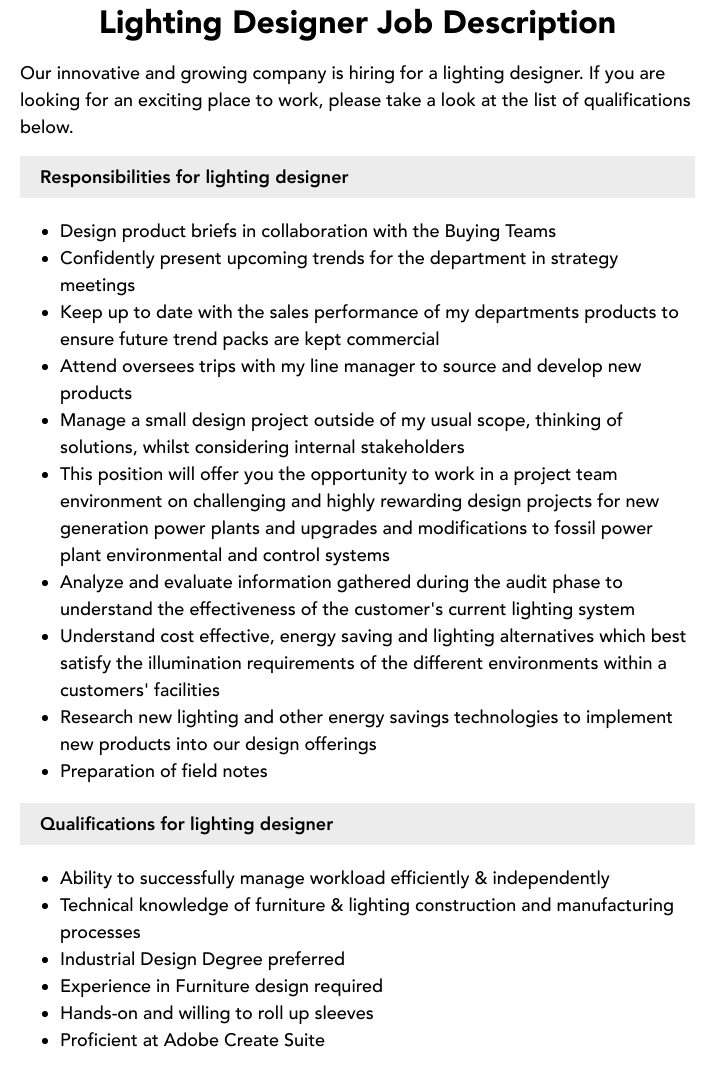


The idea that the stage should not depict a real place, but one that allows the audience to focus on the text and the actor returning to the primaries of theater – one actor, one audience, and a compelling story. Appia’s cube was innovative for a number of reasons, most importantly and separate from the norm of the day. This work can be seen as the direct forerunner to many of the Bauhaus movements’ approaches to theater and design as many of the Bauhäuslers would have directly experienced this firsthand.
#Theatrical lighting designer jobs driver
This included the three-dimensional movement of actors taking liberty with multiple levels and space to traverse the floor, perpendicular scenery, and using depth and the horizontal dynamics of the performance area.įrom this he created his construct of the Theater of Light which treated the human body, space, and light as malleable commodities to create a unified arrangement of scenery, known as “mise en scene”. This ‘white cube’ idea he developed in 1913 with composer Richard Wagner and his contemporary Edward Gordon Craig allowed them to experiment with the movement of three-dimensional scenery, actors, music, and light ultimately deciding that the lighting was the primary driver tying it all together. Faced with the theatrical productions of the day of three-dimensional actors against two-dimensional scenery and backdrops, he advocated for three elements to unify the production. His contemporary and frequent collaborator, opera legend Wieland Wagner, posited that a fundamental goal of any theatrical production was artistic unity. These innovations gave him the opportunity to advance how lighting works with the architecture of theater.Ĭonsidered the founding father of contemporary stage design, Swiss architect Adolphe Appia was one of the first scenic designers to understand the importance of using light beyond merely illuminating the stage and actors for visibility. With his architectural background, he advanced methods of changing scenic elements which became known as “scènes à l’italienne”. It is with these new creations that the idea of stage lighting for dramatic purposes including the idea of scripted changes in light synchronized to the script took hold.

He also invented the first reflector spotlight by attaching a polished basin behind a light source and the first attempt at color changing by the use of mechanisms to drop colored wine bottles over the light source. In addition to inventing sophisticated stage machinery to create realistic visual and sound effects, he is credited with the creation of machinery to dim theater lighting of its era – candlelight. They serve an aesthetic, approach, and narrative each to their own that has served to shape the environment and landscape of the architectural space:Īn Italian architect of the Baroque Period, Nicola Sabbatini was one of the most influential pioneering designers of theater in his day. This is by no means a complete list as there have been so many influential masters of the arts but have had the most influence on my own craft. With that in mind, the following are important historic and contemporary theatrical figures that I believe every architectural lighting designer should get to know. Thoughtfulness in mood, movement, angle, sense of time and place, color, area of focus, and intensity are the tenets of every theatrical lighting designer that are our paint brushes to transform a set on a stage. I often find myself reaching to theatrical artists of the past for influence and inspiration as to me, quality lighting is as much an art as it is a science as the theatricality of lighting design can have a dramatic effect on any architectural space. There are, however, quite a number of similarities that allow inspiration to be drawn from each niche group, for both large and small scale applications. As a lighting designer that spans both the theatrical world and architectural landscape, I often find myself blending the two together despite their own cultures, design conventions, and aesthetics.


 0 kommentar(er)
0 kommentar(er)
